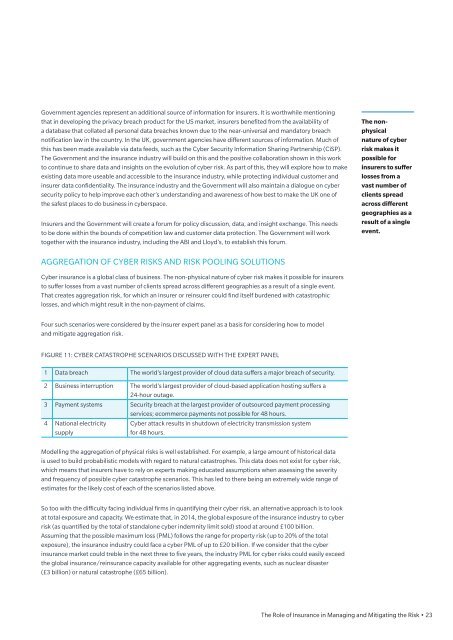k88nFi
k88nFi
k88nFi
Create successful ePaper yourself
Turn your PDF publications into a flip-book with our unique Google optimized e-Paper software.
Government agencies represent an additional source of information for insurers. It is worthwhile mentioningthat in developing the privacy breach product for the US market, insurers benefited from the availability ofa database that collated all personal data breaches known due to the near-universal and mandatory breachnotification law in the country. In the UK, government agencies have different sources of information. Much ofthis has been made available via data feeds, such as the Cyber Security Information Sharing Partnership (CiSP).The Government and the insurance industry will build on this and the positive collaboration shown in this workto continue to share data and insights on the evolution of cyber risk. As part of this, they will explore how to makeexisting data more useable and accessible to the insurance industry, while protecting individual customer andinsurer data confidentiality. The insurance industry and the Government will also maintain a dialogue on cybersecurity policy to help improve each other’s understanding and awareness of how best to make the UK one ofthe safest places to do business in cyberspace.Insurers and the Government will create a forum for policy discussion, data, and insight exchange. This needsto be done within the bounds of competition law and customer data protection. The Government will worktogether with the insurance industry, including the ABI and Lloyd’s, to establish this forum.The nonphysicalnature of cyberrisk makes itpossible forinsurers to sufferlosses from avast number ofclients spreadacross differentgeographies as aresult of a singleevent.AGGREGATION OF CYBER RISKS AND RISK POOLING SOLUTIONSCyber insurance is a global class of business. The non-physical nature of cyber risk makes it possible for insurersto suffer losses from a vast number of clients spread across different geographies as a result of a single event.That creates aggregation risk, for which an insurer or reinsurer could find itself burdened with catastrophiclosses, and which might result in the non-payment of claims.Four such scenarios were considered by the insurer expert panel as a basis for considering how to modeland mitigate aggregation risk.FIGURE 11: CYBER CATASTROPHE SCENARIOS DISCUSSED WITH THE EXPERT PANEL1 Data breach The world’s largest provider of cloud data suffers a major breach of security.2 Business interruption The world’s largest provider of cloud-based application hosting suffers a24-hour outage.3 Payment systems Security breach at the largest provider of outsourced payment processingservices; ecommerce payments not possible for 48 hours.4 National electricitysupplyCyber attack results in shutdown of electricity transmission systemfor 48 hours.Modelling the aggregation of physical risks is well established. For example, a large amount of historical datais used to build probabilistic models with regard to natural catastrophes. This data does not exist for cyber risk,which means that insurers have to rely on experts making educated assumptions when assessing the severityand frequency of possible cyber catastrophe scenarios. This has led to there being an extremely wide range ofestimates for the likely cost of each of the scenarios listed above.So too with the difficulty facing individual firms in quantifying their cyber risk, an alternative approach is to lookat total exposure and capacity. We estimate that, in 2014, the global exposure of the insurance industry to cyberrisk (as quantified by the total of standalone cyber indemnity limit sold) stood at around £100 billion.Assuming that the possible maximum loss (PML) follows the range for property risk (up to 20% of the totalexposure), the insurance industry could face a cyber PML of up to £20 billion. If we consider that the cyberinsurance market could treble in the next three to five years, the industry PML for cyber risks could easily exceedthe global insurance/reinsurance capacity available for other aggregating events, such as nuclear disaster(£3 billion) or natural catastrophe (£65 billion).The Role of Insurance in Managing and Mitigating the Risk • 23


